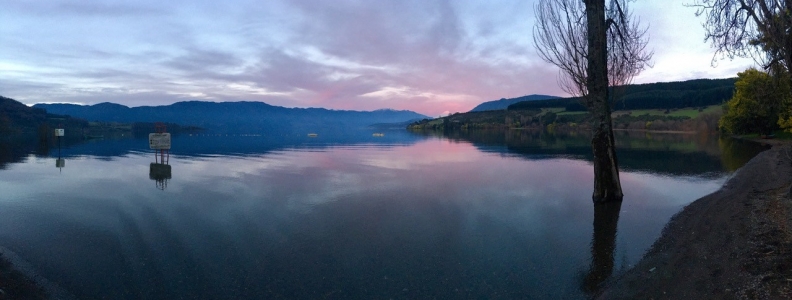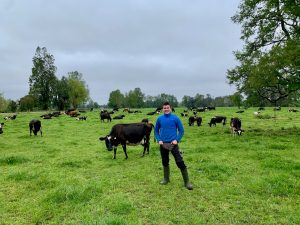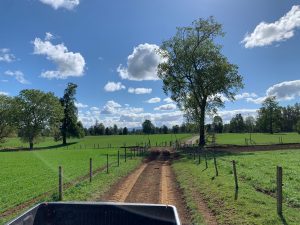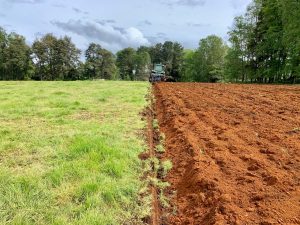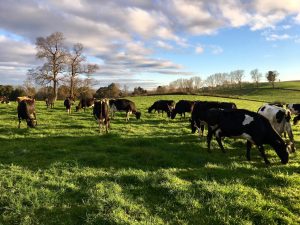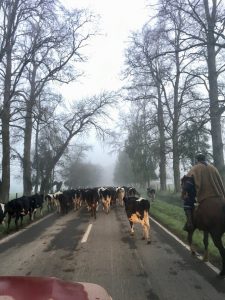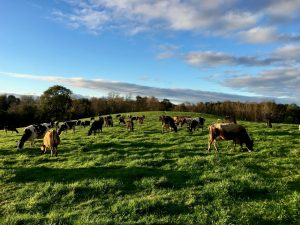Dáire Brady, studying Dairy Business in UCD talks about his time on work experience abroad.
Writing the beginning of this blog, I am currently looking out over Plaza De Armas in Santiago, Chile, nearing the end of my tenth week of Professional Work Experience (PWE), all the while mulling over the fact that I am now over half way through my placement. Where has the time gone? How on earth did I end up here? Having the opportunity to spend time abroad was a major factor in the determining which course I would opt for at 3rd level.
Dairy Business in UCD was an obvious choice, with two years based out of Belfield, a trimester abroad coupled with a trimester in Teagasc Moorepark, culminating in a final year based out of Belfield once again. The Dairy Business degree offers students the opportunity to complete 20 weeks of work placement either in Ireland or abroad, the latter being the more popular choice, and no different this year with over half the class ‘tiki-touring’ across the globe to the dairying colossus that is New Zealand. For me, New Zealand seemed like a great option, proven system of production, world leader, dairying culture, great social life; It ticks all the boxes. However, when the opportunity to travel to South America and work with a corporate fund on a dairy portfolio arose, I had to seize the opportunity. Somewhat of an outlier, I hopped on a few planes and ended up in southern Chile.
Arriving in Chile
Arriving into Chile, I’m sure I took the award for the biggest ‘gringo’ in Santiago airport that day. T-shirt, shorts and a Miami-heat baseball cap were quickly swapped for jeans, a fleece and a jacket. In my defence, I had spent the week previous in the 33-degree heat of Havana, however, little did it prepare me for the -3 degrees I was faced with in Los Ríos, Southern Chile. I was unsure of what to expect. Brief research on the connecting flight southbound indicated that Chile is a nation with a rich history, has a rather significant indigenous population, possesses the most stable economy in Latin America while also being one of the most open economies in the world and that wealth inequality was a problem. With a population of approximately 18 million people, 90% of which live within the middle third of the country, typically around the greater Santiago area, I was questioning whether there would be civilisation where I was headed. Unlike other southern hemisphere countries renowned for their scale in dairying, for instance, New Zealand, Brazil and Argentina, Chile is a relatively small player in the game. However, upon landing it became clear that southern Chile, and in particular the Los Ríos and Los Lagos regions, epitomise the fertile crescent of dairying in Chile. Roughly located within the same parallels as Taranaki and South Canterbury in New Zealand, the southern plains and their temperate grasslands share many ecological and climatic factors with New Zealand, thus it comes as no surprise that the region has adopted many of the same techniques as practiced by the world’s largest dairy exporter, as well as attracting quite a lot of foreign investment over the past quarter century.
Settling In
Adjusting to the culture is Chile was relatively easy, aside from the language, which I’m told is the equivalent of trying to understand east-Kerry Spanish, driving on the right and having your headlights on all the time were probably two of the things I struggled most with!
Simple tasks can at times prove difficult here, mainly due to government regulation. Foreigners tend to be subject to more expensive prices when compared to locals; this is not only seen in basic items such as street food or the price of repairing a puncture, but also in the price of farmland. I call it the ‘gringo tax!’ I am still getting my head around the currency, the Chilean Peso, which is currently at €1:$791 CLP. Paying fifty thousand for groceries is not something I’m used to in my local supermarket at home. It will probably be the first (and last) time I will have a million in a bank account!
Initially, I was unsure of how the staff and locals would take to a gringo (foreigner) working among them. However, I quickly learned that Chileans are among the most open and welcoming people I have ever met. I am beginning to think that they are the Irish of South America in terms of socialising and having fun!
Working Abroad
My first day on the farm, which I still joke about with the farm managers, was spent on the 350- hectare runoff block. Expecting there to be a quad, or some form of ATV, it’s fair to say I was surprised when the manager emerged, rein in hand, with a stallion. Watching the horseback veterans herding cattle is a sight to see. I’ve come to the conclusion that one good person on horseback is as good as three on foot! The model adopted by the fund is the ‘low-cost’ grass- based model, effectively emulating the model present across the South Pacific in New Zealand. Milk price is relatively similar to Ireland, although the payment system varies considerably among milk processors, and can often include between ten and twenty payment factors. Mainly spring calving, the fund operates three farms and a run-off block with approximately 3000 cows milked peak milk.
To date my role varies quite a lot, depending on which of the four farms in the portfolio tends to be the busiest. Gaining an insight into corporate farming from multiple aspects of the operation really is a once in a lifetime experience. Any one day could be spent calving, weighing heifers, discussing the price of milk with processors or even attending an anti-corruption in commerce meeting. That was a first!
Exploring Chile
Downtime is spent barbecuing or, of course, playing football. Football is the religion and Alexis Sánchez is God. Inter-farm derbies are a regular occurrence and as I quickly realised, have little to no rules.
My PWE fell over the national holiday, ‘Dieciocho’, which I’m told is the most celebrated holiday in Chile. Vaqueros (cowboys), Cueca dancing and parades lined the streets in the local village. Patriotism is certainly live and well in Chile.
Having the opportunity to work, travel and experience a completely unique culture shaped by peculiar traditions and social norms for such a period of time is an element which is unique to the Dairy Business course. Thankfully I have seized this opportunity and visited some of the sights Chile has to offer during my time off. Home to the Atacama Desert, one of the driest places on earth, the Andes, the longest continental mountain range on the planet and amazing seaside towns such as Valparaíso and Vína del Mar, Chile certainly has much to offer in terms of tourism and social life.
Spanning over three climates, Chile also possesses a lot in terms of agriculture. In the semi-arid north, fruit and horticulture line the valleys, in the central zone, some of the largest wine producers in Latin America, for instance, Casillero del Diablo, exist and in the south, cereals, forestry, dairy and beef enterprises dominate.
Fortunately, I have also had the opportunity to visit one of the largest grassland dairy farms in the world, Manuka Chile, which operates a 22,600-hectare estate milking over 40,000 cows, with plans to increase to near 70,000.
To date, my experience in Chile and South America has been a real eye-opener. Every day presents a new challenge and is truly unique. The more time I spend here and people I encounter, be it farmers, staff, vets, AI technicians, contractors and locals the more I become fascinated by the nation and its culture.
I am ever so much grateful to both the Irish Farmers Journal and Agricultural Science Association for supporting me in my journey to date through their travel bursary.


